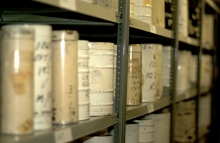Behind the Scenes of Operation Crossbow
The 3D wartime aerial photographs featured in a recent BBC documentary were uncovered after six months of painstaking research by NCAP Curator Allan Williams and his team. Operation Crossbow, broadcast on BBC Two in May 2011, tells the story of the critical role played by aerial photographic intelligence in the hunt for the Nazi ‘Vengeance’, or ‘V’ weapons, during the Second World War.
In that single operation, Allied reconnaissance pilots took over 1.2 million photographs. Finding the key historical images within the vast and largely uncatalogued NCAP archive required months of in-depth detective work. After consulting squadron records held at The National Archives in Kew, and sortie plots showing Spitfire and Mosquito flight paths, the team then sifted through thousands of photographs to find the exact images used by the photographic interpreters 60 years ago to discover V-weapon launch sites.
Created as working documents to be used during wartime conditions, the long term survival of the imagery was not a priority at the time. It was processed rapidly to ensure that it could be exploited for intelligence as quickly as possible. Upon locating the right images, the NCAP team carefully preserved and digitised them. Digital copies of the photos – which were originally taken in stereo so they could be viewed in 3D – were then supplied to the documentary makers, who recreated the 3D effect on screen using computer graphics.
By geo-cataloguing each of the digitised images, the NCAP team were able to cross-reference the historic imagery with map-accurate locations in the modern landscape. As a direct result of this work, around 10,000 never-before-seen images, many of which document key V-weapon sites, are available to view online.
In addition to research, preservation, digitisation and cataloguing, the team developed geo-rectification techniques to prepare a mosaic of Bois Carre - the first V-1 launch site to be identified and analysed by Allied photographic interpreters in November 1943. The geo-rectification process matches the vertical aerial image to geographic coordinates so that each pixel of the images is map-accurate.
NCAP Curator Allan Williams said: Modern special effects provide an excellent illustration of how the images we hold in the National Collection of Aerial Photography were used during wartime. We often think of 3D as a recent innovation, but over half a century ago this technology – which in fact dates back to the Victorian era – allowed the photographic interpreters of World War Two to make sense of the fine details hidden in the enemy landscape. Looking at these photographs through stereoscopes is like looking at a scale model.
During the filming of Operation Crossbow, Allan travelled to France with veteran photographic interpreters Wing Commander Mike Mockford and Major Chris Halsall to visit the remains of V Weapon launch and test sites. Allan and the NCAP team represent the legacy of the WWII photographic intelligence unit that was based at RAF Medmenham in Buckinghamshire. Over the past few years, the Ministry of Defence has declassified millions more ‘top secret’ archive images from Medmenham – and other MoD collections – that are now held by NCAP.
Allan said, The recent BBC documentary shows the invaluable role NCAP can play in revealing and illustrating untold stories in major conflicts from the Second World War onwards. With the vast majority of our millions of images never having been seen before by the public – or even by anyone outside of the intelligence community – further investigation into the archive could dramatically change our understanding of world history. NCAP is an unparalleled resource, with the potential to provide military historians and researchers with many new, unique and unexplored perspectives on wartime events.


